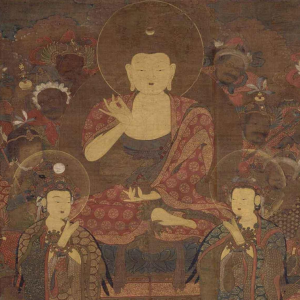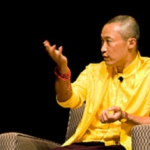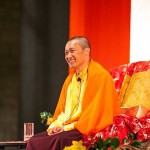Thursday
Dying & Death Classes on Shambhala Online
By Alley Smith

Death is the greatest of all teachers. –The Buddha
Shambhala Online has been offering a variety of courses on topics related to dying and death. These topics enable the sangha and outside community members to gather and think about death, engage in contemplative practices, and toil with topics such as fear, anxiety, the unknown, and how to have conversations about death.
The Shambhala community is gathering with purpose: to understand the dying process, to recognize and articulate the role of spiritual, religious and existential support, practices, and cultural norms within the modern Buddhist context. The result is tremendous openness and courage to face the inevitable and unknown in a gentle and relaxed way.
As Chögyam Trungpa Rinpoche says, Life is painful with an occasional speck of pleasure. We are born, we get old, we experience sickness, and, last but not least, we die. We are each waiting to die. I’m afraid that is the bad news. Whether you are young or old doesn’t make much difference – everybody will eventually die. So now is the time to do something with your life. We are not interested in developing eternity or immortality, or in preventing being sick or being born. We are interested in doing something while we are alive, while we are breathing, while we see the beauty of the snow, the flowers, the blue sky, the sunshine and many other things we can imagine.
While we are alive we can explore our personal belief systems about dying and death, our struggles, vulnerabilities, strong emotions, personal values, needs, and much more. Death has so much to teach us. Even as the Buddha was dying, he taught that suffering (dukkha) comes from not living in accordance with the truth of impermanence and interdependence. Death itself is a profound spiritual transmission.
Students have been gathering across the global community at Shambhala centers in Seattle, Dallas, Halifax, Los Angeles, and Philadelphia to offer support and practice advice. Communities are interested and invested in doing something while they are alive, while breathing, to be embraced by the sangha, to be met with unconditional kindness and the warmth of the Great Eastern Sun.
In the end, everything is left up to the individual. Therefore, most Buddhists do not take the truth of impermanence half-heartedly. Whether we are studying the Tibetan Book of the Dead, teachings of Amitabha Buddha, the Pure Lands, Sukhavati, Bodhichitta, the Bardos, and a vast array of teachings, we must do as many great Rinpoches and Tibetan lamas suggest. Engage in whichever practices are clearest, familiar, and most vivid on our deathbeds.
While we are alive we must be willing to face old age, sickness, and death with confidence and fearlessness. We must abandon any notion of resentment and attachment. Ask yourself, why would the Buddha say, Death is the greatest of all teachers? What can we learn from his words? In the end, as Trungpa Rinpoche says, “It’s up to you sweetheart.”
Shambhala Online would like to invite you to attend any one of these upcoming sessions in 2025:
Fear & Fearlessness: Navigating Life & Loss
March 27. During this online session, we will explore Chögyam Trungpa Rinpoche’s teachings on “Fear and Fearlessness” from the timeless classic, Shambhala: The Sacred Path of the Warrior.
The Buddha’s Discourse on Teachings to Be Given to the Sick
November 1. During this mini-retreat, we will read and explore the Buddha’s Discourse on the Teachings to Be Given to the Sick. We will examine traditional Buddhist teachings on the six senses, six sense objects, six elements, the five aggregates, and more.
Making Friends with Death & Dying: Support Group (1st Monday night of every month)
Next session April 7. Support group sessions will include a short talk, meditation practice, and an open forum to discuss personal experiences with old age, sickness, death, grief and bereavement. All are welcome. We respect your privacy. These sessions will not be recorded.
The 49 Day Ceremony: A Celebration of Life & Death
December 13. Join Chaplain Alley Smith for a 3-hour online mini-retreat as she guides participants into a deeper understanding of the 49 Day Ceremony and the common Buddhist practices and rituals that follow someone’s death – all within a modern Buddhist context.
Alley Smith (she/her) is an ordained Zen Buddhist Chaplain, scholar, researcher, and lecturer who serves at a college and university. Alley is deeply influenced by Pure Land Buddhism and Vajrayana. She has been a member of Shambhala and Zen since 1999. Alley works in the funeral industry in Vermont. She teaches a number of courses on Shambhala Online.
Entries filed under Dharma Teachings
Protecting Relationships During Don Season – HIGHLIGHT
by Acharya Susan Chapman, Vancouver B.C. Because it was scheduled many months ago, by coincidence last night’s opening class of our Mindful Communication course occurred on the first day of Don Season. Around 40 people, mostly newcomers, listened to the tinkling of the bells from the Mamo chants ... continuePosted February 7, 2013 by
The Gate of Cosmic Warfare – HIGHLIGHT
Invoking the Energy of Protection by Toby Sifton, Rupon There is a sentry at the gate 24 hours a day regardless of the activity happening within. Someone stands at the edge peering out from under a tarp against rain that never seems to end, or roasts in the ... continuePosted February 6, 2013 by
Averting the Negativity of the Old Year – HIGHLIGHT
A Look at the End of the Water Dragon Year, and the Mamo Days practice time by Dorje Loppon Lodro Dorje The year end Mamo Days practice is a means of clearing up the environmental negativity of the whole year. It is traditional at this time to invoke the ... continuePosted February 5, 2013 by
Don Season Teachings – HIGHLIGHT
Teachings and Q & A from Sakyong Mipham Rinpoche compiled and made available by Hamish Maclaren The following two videos are from a 2008 Shambhala Online session with the Sakyong teaching about the don season. Both videos include teaching as well as question and answer and both now ... continuePosted February 3, 2013 by
The Soil at the Root of Loneliness – HIGHLIGHT
by William Brown, Los Angeles On a rainy Sunday morning twenty years ago I was leaving a diner in Seattle. Just as I passed the pay phones and touched the door, I heard a woman behind me say, “I’m just so lonely that I don’t know what ... continuePosted January 28, 2013 by
What Now? – HIGHLIGHT
photo courtesy of Andrea RothA teaching from a public talk at Grace Cathedral, San Francisco by Sakyong Mipham Rinpoche My father, Chogyam Trungpa, was one of the last great teachers to be trained fully in Tibet while it was still a spiritual kingdom. He told me that even ... continuePosted December 1, 2012 by
Ancestors, Investigated – HIGHLIGHT
Charlemagne Equestrian statue 9th century, from www.shafe.co.ukWho might be considered the Western Ancestral Sovereigns of Shambhala? by Greg Lubkin, Los Angeles Some of my friends in Nova Scotia have been talking about the idea of Western Ancestral Sovereigns and wondering why there hasn’t been more written about that ... continuePosted September 19, 2012 by
Why I Meditate: “Because It Works!” – HIGHLIGHT
cushion,by Kevin Townley, from The Under 35 Project I remember reading somewhere that the first step in getting disentangled is experiencing entanglement. You have to be able to see what’s going on before you can have a workable relationship with it, and this is what I’ve found ... continuePosted August 13, 2012 by
The Path of “Hi” – HIGHLIGHT
guest article by Susan Piver Hi there! This morning, I went for a run at about 6:30am. The streets were mostly deserted but occasionally I would pass someone on the sidewalk. When I did, I said, “hi.” OK, I live in Boston. Boston is not a hi-saying town. ... continuePosted July 30, 2012 by
Gesar in Story and Song, part 2 – HIGHLIGHT
Audio recording offered by Khenpo Gawang Rinpoche to the Shambhala community When you tell the story of buddhas and bodhisattvas, there are many ways to tell them: outer, inner and secret biographies. In this case, we’re going to tell the outer biography of Gesar. He is the son of ... continuePosted June 1, 2012 by
Making the Most of Retreat… – HIGHLIGHT
…and Bringing It to Life by Irini Rockwell Director & Principal Coach/Trainer at Five Wisdoms Institute Taking a retreat, however long, is a precious opportunity to look deeper within ourselves by connecting with life transformative practices. So how do we bring the awareness and intelligence of the retreat back into ... continuePosted May 23, 2012 by
Eleanor: Unbiased at the Root – HIGHLIGHT
Shastri Column: This article is part of a series of articles by Shastris – senior Shambhala teachers – on themes that Sakyong Mipham Rinpoche has been emphasizing in his teachings on basic goodness. This article by Shastri Diana Evans explores the path of living into fearlessness ... continuePosted March 8, 2012 by
Shambhala Day Guided Meditation
This guided meditation by Sakyong Mipham Rinpoche was offered to the Shambhala community on Shambhala Day, following the address given by the Sakyong Wangmo. Those of you who are sitting on cushions, and those of you who are on chairs, please take a good posture. Especially ... continuePosted February 27, 2012 by
Ordinary Bravery – HIGHLIGHT
Shastri Column: This new article is part of a series of articles by Shastris – senior Shambhala teachers – on themes that Sakyong Mipham Rinpoche has been emphasizing in his teachings since he ended his year-long retreat almost a year ago in March, 2011. This article ... continuePosted February 6, 2012 by
Gesar in Story and Song – HIGHLIGHT
Inspired by the profound teachings of Gesar of Ling, the mythical, historical, holder of sacred buddhist teachings, Khenpo Gawang Rinpoche has offered the Shambhala Times readers an audio gift of song and story. This broadcast tells the story of Gesar going to India and the hell ... continuePosted December 15, 2011 by
![]() RSS feed for the Dharma Teachings category
RSS feed for the Dharma Teachings category
View all posts from authors in Dharma Teachings: jillian_johnson
























